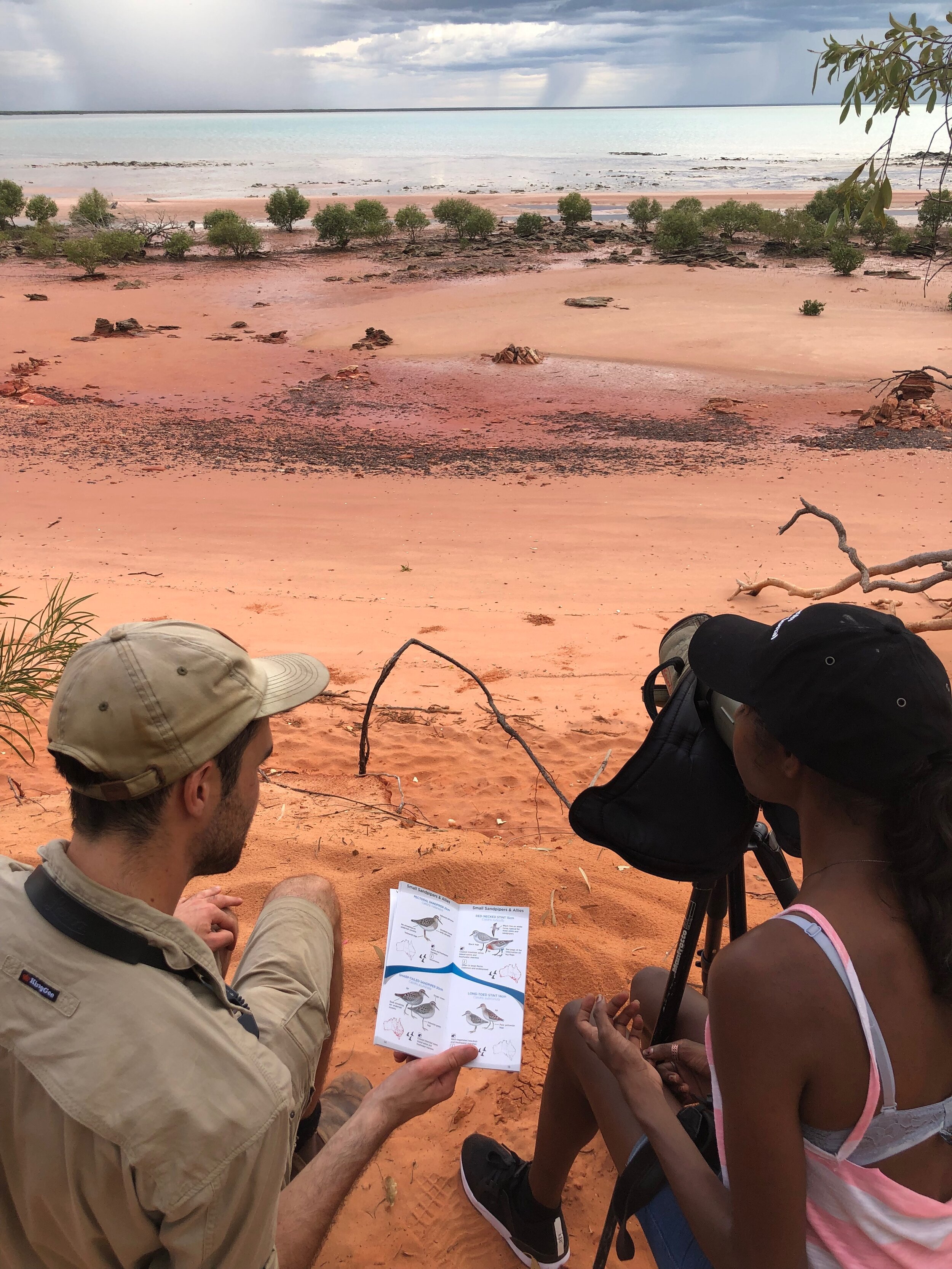Education in Roebuck Bay
Like any organisation, the interactions people have with the BBO are varied and each person has a unique experience. You may have attended a tour at the BBO, camped the night under the milky way or read our interpretive boards as you pop in for a cold soft drink after a long day fishing at Crab Creek. The fundamental to all these interactions and the core foundation of the BBO is our role as an education facility.
It’s arguably the most important facet of the BBO, to inspire, inform and engage the public about the incredible birdlife in Roebuck Bay and its unique and precarious status on the global scale.
Through our birding tours, courses, weekly market stall and volunteer opportunities we aim to meet these objectives. The most valuable and rewarding education programs are when young people are engaging with birds for the first time. The school-aged programs (and younger) are always fulfilling as this is often children’s first time using binoculars, we can promote play-based learning and is a great opportunity to deliver STEM (Science, Technology, Engineering, Maths) curriculum in a real-world setting, creating greater meaning for the children’s learning experience.
Some fantastic impressions of the Australian White Ibis by Roebuck Primary students
Also, it keeps us on our toes. There is no predicting what the children will ask! Favourites so far include:
‘Why do you wear those uniforms?’ (good point) and ‘what is the youngest bird in the world?’ (a rhetorical questions or is the answer just ‘an egg?’)
This year we have hosted students from the Broome Nature Playgroup up to the Youth Program of the North Regional TAFE (and everything in between).
Recently BBO staff attended two classes at Roebuck Bay primary as the students were learning about nests and birds through their STEM curriculum. With binoculars and scopes in tow we discussed bill adaptations and nest building practices with the students and we took the students (or perhaps they took us?) on a bird walk around the grounds. Roebuck Primary play-ground and oval has a very impressive bird list with Red-collared Lorikeets, Little Friarbirds, Straw-necked and White Ibis, Pied Butcherbird, Brown Honeyeater and Tawny Frogmouths. The students at Roebuck Primary now have their own list that they can add a species to every time they twitch a new bird in their school grounds.
‘Greenshank eggs are laid on the opposite side of the world in Siberia’. Some of the reflections students from Roebuck Primary had after the BBO staff visited.
Jane and Merryn returned to Roebuck Primary to run a session on shorebird disturbance with the students producing their own interpretive signs for use at the BBO office.
‘Be careful of shorebirds’ these posters have pride of place at the BBO
A fantastic Red Knot asking for a bit of space at high tide
While we enjoy heading into town and doing school incursions, it’s great to facilitate education programs from the Observatory itself. Broome Nature Playgroup visited earlier in the month, with most children aged a few months to 5 year old it was great to have the kids walk around the grounds, enjoy some morning tea in the Shadehouse while watching the bird baths and examining the items on the nature table.
The kids from Nature Play Group keenly watching the bird baths after having a walk to the viewing platform
The nature table set up in the Shadehouse proved popular.
It’s not just primary school-aged students who join us at the BBO. Six students from Broome’s TAFE joined us earlier in the year for migration watch and to gain some shorebird ID skills. After a quick briefing and with telescopes and shorebird ID booklets (a common theme in everyone of our education sessions) we headed to the Migration Watch point with the students. From where this Warden currently types after a long and particularity parched Dry season, those clouds and rainfall seem like a very distant memory! We even had to abandon Migration Watch early due to a spectacular lightning display over the bay.
These Shorebird ID Booklets are a fantastic resource that we use with every age group.
The Youth Program students checking out the migration on low tide. Again- look at the clouds - RAIN!
We’re so fortunate in Broome to have a community of like-minded who place such value on the environment and understand the importance of incorporating it into our education.We’re working on creating a Broome-specific shorebird curriculum that can be used by educators to tie directly with the Australian Curriculum. In the meantime we will continue to welcome all visitors and learners to the BBO and hope they leave with an enhanced appreciation and knowledge for this incredible bay and it’s bird life.
- Jane








